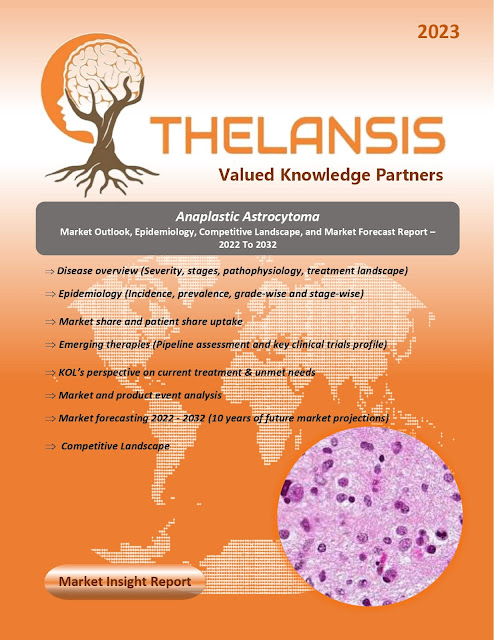Anaplastic Astrocytoma – Market Outlook, Epidemiology, Competitive Landscape, and Market Forecast Report – 2022 To 2032
Anaplastic astrocytoma is a rare, aggressive type of brain tumor characterized by an abundance of abnormal astrocytes and high numbers of cells dividing. It is often associated with diffuse infiltration of the surrounding tissue, considerable swelling, and compression of adjacent brain tissue. It typically occurs in the frontal and temporal lobes of the brain, brain stem, or spinal cord. It constitutes 4% of all malignant central nervous system tumors and 10% of all gliomas. Depending on where the tumor is located, patients may present with symptoms such as headaches, vomiting, seizures, and changes in behavior or neurological function. An anaplastic astrocytoma can be classified further into different subtypes based on genetic characteristics, including mutations in the IDH1 or IDH2 genes. These genetic differences can affect treatment options and prognosis, with varying systems of classification based on the presence or absence of these mutations.
·
The 5-year survival rate for anaplastic
astrocytoma is 22%, with the highest survival rate in patients aged 15-24 years
and the lowest in patients aged 75-84.
·
Anaplastic astrocytoma is the most common form
of anaplastic glioma, with an annual incidence of 0.53 cases per 100,000 people
in the US.
Thelansis’s “Anaplastic Astrocytoma
Market Outlook, Epidemiology, Competitive Landscape, and Market Forecast Report
– 2021 To 2032" covers disease overview, epidemiology, drug utilization,
prescription share analysis, competitive landscape, clinical practice,
regulatory landscape, patient share, market uptake, market forecast, and key
market insights under the potential Anaplastic Astrocytoma treatment modalities
options for eight major markets (USA, Germany, France, Italy, Spain, UK, Japan,
and China).
KOLs insights
of Anaplastic Astrocytoma across 8 MM market from the centre of Excellence/
Public/ Private hospitals participated in the study. Insights around current
treatment landscape, epidemiology, clinical characteristics, future treatment
paradigm, and Unmet needs.
Anaplastic Astrocytoma Market Forecast Patient
Based Forecast Model (MS. Excel Based Automated Dashboard), which Data Inputs
with sourcing, Market Event, and Product Event, Country specific Forecast
Model, Market uptake and patient share uptake, Attribute Analysis, Analog
Analysis, Disease burden, and pricing scenario, Summary, and Insights.
Thelansis Competitive Intelligence (CI) practice
has been established based on a deep understanding of the pharma/biotech
business environment to provide an optimized support system to all levels of
the decision-making process. It enables business leaders in forward-thinking
and proactive decision-making. Thelansis supports scientific and commercial
teams in seamless CI support by creating an AI/ ML-based technology-driven
platform that manages the data flow from primary and secondary sources.




Comments
Post a Comment